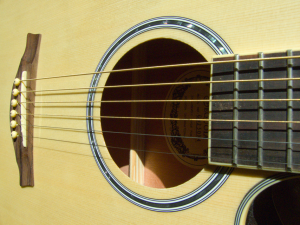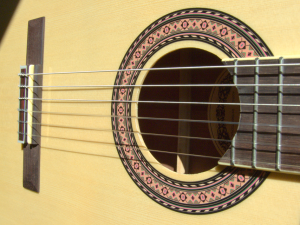Guitar strings affect the tone of your guitar, its ability to play in tune, and even how easy it is to play. While it may seem obvious that it is important to know about strings when learning guitar, not everyone takes the time to research the subject.
Different Guitars Use Different Types of Guitar Strings


Guitars are designed to use certain types of guitar strings. For example, electric and steel-string acoustic guitars are built to use metal strings. They feature a metal truss rod which runs through the center of the guitar neck. The truss rod braces the neck against the tension of strings pulling forward. Also steel-string acoustic guitars terminate the strings to bridge pins while electrics use other methods. Classical and folk guitars use nylon strings and have no truss rod. You can’t use metal strings on classical guitars or you might damage the guitar.
Here are links to learn more about the specific types of guitar strings:
Types of Guitar String Materials
Steel-string manufacturers are often creating new alloys and winding techniques. A wound string features one string coiled tightly around another. Materials used for creating metal guitar strings include steel, nickel, brass, bronze, and a multitude of custom alloys. The wound strings can be round, filed to half-round, or flat. String materials are chosen based on the desired tension, acoustic or amplified tone, and playability. For example, flat wound strings sound less bright and hide finger fret noises. Note that if you changing your string gauge you may also need to adjust your guitar setup to re-balance the instrument and keep strings from getting caught in the nut slots. Note that these types of guitar strings are usually associated with different musical styles such as using flat-wounds for jazz, stainless round wounds for rock, etc.
In order to slow down the inevitable corrosion of metal strings, some manufacturers offer metal strings coated with very thin layers of plastic. Although coated strings are never as bright-sounding as uncoated strings, the tone tends to stay consistent over a longer period of time.
Classical guitar strings were traditionally made from sheep or cow intestine and silk. Today we use nylon, and the three bass strings are wound by threads of silver-plated bronze or copper wire.
Gauges of Guitar Strings
String gauge is another way of saying string “thickness.” String gauges can vary from .008 inch for plain strings to .055 inch for heavy wound strings. Smaller gauge strings have a lighter sound. They are easier to bend, but they can break more often. Heavier gauge strings produce a louder (or heavier) sound and are a little tougher to bend, but they are more durable. It is usually better for a beginner to start with lighter gauge strings and go heavier as hand strength increases.
Guitar strings break more easily as they age because they lose their pliability. If you regularly break strings, you might inspect the bridge and nut slots for sharp corners and file them down. When replacing a single string, be sure to pick the right string from your replacement set since each of the six strings is of a different thickness.
The Types of Guitar Strings You Use Affects Guitar Playability
Steel strings can be hard on fingers because of their stiff material and tension. A metal string holds up well against hard strumming with a pick. Bending a steel string is more difficult if it is a heavier gauge. Using a light gauge strings, you’ll find it easier to bend strings, but the volume of the string will be weaker.
Nylon strings are very easy on your fingers and easy to hold down. For these reasons, a nylon-string guitar may be preferred by beginners; however, there are some noteworthy challenges. Because nylon strings are thicker and need more space to vibrate on the neck, the guitar necks tend to be wider. Some guitar chords may be more difficult to reach on a wider neck, especially for smaller hands. Also, while bending nylon strings is easy, the resulting change in pitch tends to be very slow. It’s very difficult to precisely bend a note played on a nylon string from one pitch to another.